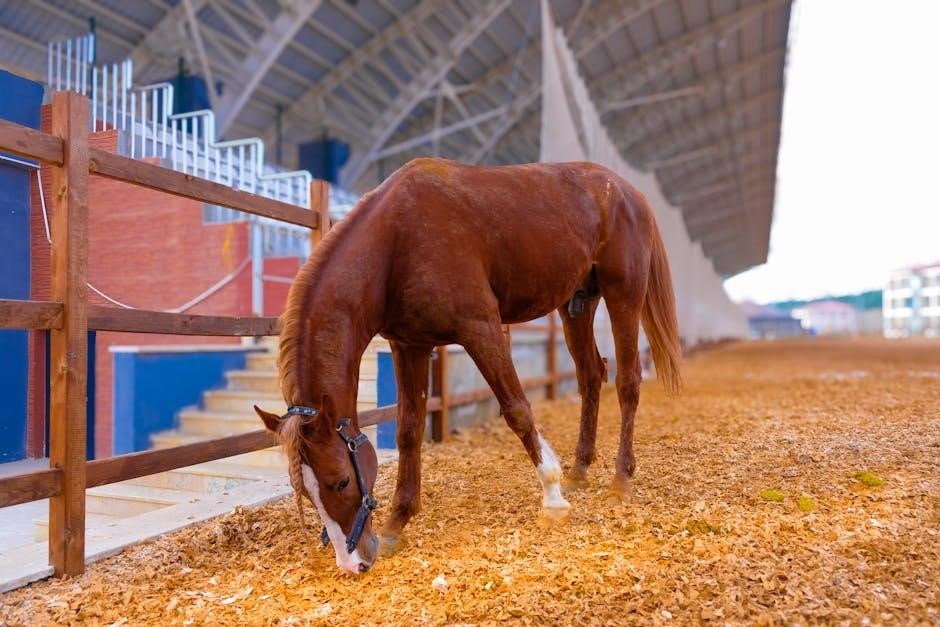Understand when and how to blanket your horse with this guide, covering factors like climate, coat type, age, and weather, plus the essential 55°F rule for comfort.

Why Blanketing Your Horse Matters
Blanketing your horse is crucial for protecting them from cold and wet conditions, ensuring their comfort and health. Horses rely on their coats and body systems to stay warm, but extreme weather can challenge their natural thermoregulation. Blankets provide extra insulation, preventing heat loss and keeping muscles relaxed. Wet conditions can strip their coat’s insulating properties, making blankets essential. Young, senior, or clipped horses especially need protection. The 55°F rule is a key guideline—blanket when temperatures drop below this threshold. Proper blanketing supports their well-being, preventing discomfort and potential health issues. It’s a vital practice to ensure your horse stays warm and thriving year-round.
Factors Influencing Horse Blanketing Decisions
Climate, coat type, age, health, and weather are key factors in deciding when to blanket your horse to ensure comfort and prevent heat loss effectively.
Climate and Geographic Location
Climate and geographic location play a significant role in determining when and how to blanket your horse. Horses in colder climates or regions with harsh winters may need heavier blankets earlier in the season. In contrast, horses in milder or warmer climates may require lighter blankets or even no blanketing at all. The 55°F rule is a helpful guideline—blanketing is generally recommended when temperatures drop below this threshold. Additionally, wet weather and wind can make your horse lose heat faster, even in warmer climates, necessitating waterproof turnout blankets. Understanding your local climate and its extremes will help you make informed decisions about your horse’s blanketing needs.
Horse Coat Type and Length
The type and length of your horse’s coat are critical factors in deciding when to blanket. Horses with a full winter coat may not need heavy blanketing until temperatures drop significantly, while clipped horses lose their natural insulation and require earlier intervention. Lightweight blankets are suitable for horses with a full coat in mild winters, but heavier options are necessary as temperatures decline. The 55°F rule serves as a guideline, but adjustments should be made based on your horse’s coat. For example, a horse with a full coat may not need blanketing until temperatures fall below 50°F, while a clipped horse may require it at 60°F or lower to stay warm and comfortable.
Horse Age and Health Status
Horse age and health play significant roles in blanketing decisions. Young foals and senior horses often struggle with cold temperatures and may require earlier or heavier blanketing. Horses with health issues, such as respiratory problems or thin body condition, benefit from additional warmth, especially in cooler climates. The 55°F rule can be adjusted for these individuals, with blanketing recommended at higher temperatures to ensure comfort. Monitoring their physical condition and behavior is crucial, as seniors may lose insulating ability, while young horses may not yet regulate body heat efficiently. Always consider their overall health and energy levels when deciding on the appropriate blanket weight and type to maintain their well-being during colder months.
Wet Weather and Wind Conditions
Wet weather and wind significantly impact a horse’s ability to stay warm, as a soaked coat loses insulating properties. Even at temperatures above 55°F, blanketing may be necessary to prevent chilling. Wind exacerbates heat loss, making it feel colder than the actual temperature; Waterproof turnout blankets are crucial in these conditions to keep your horse dry and insulated. Always monitor your horse’s comfort, as wet and windy conditions can quickly lead to hypothermia, especially in clipped or senior horses. Blanketing decisions should prioritize protecting your horse from moisture and wind to maintain their body heat and overall well-being during inclement weather.

Types of Horse Blankets
Horse blankets come in lightweight, medium-weight, and heavyweight options, designed for varying weather conditions. Turnout blankets are waterproof, ideal for outdoor use, while stable blankets suit indoor settings.
Lightweight Blankets
Lightweight blankets are perfect for milder weather, offering minimal insulation. They typically have 80-120 grams of fill and are ideal for temperatures between 40°F-60°F for clipped horses or 30°F-50°F for those with a natural coat. These blankets prevent chilling without overheating, making them suitable for spring and fall. They are also a good choice for horses that are sensitive to heavier blankets or those in transitional seasons. Lightweight options often feature breathable materials, ensuring comfort and preventing moisture buildup. They are an essential layering piece for horses that need just a bit of extra warmth without bulk.
Medium-Weight Blankets
Medium-weight blankets are designed for colder conditions, typically suitable for temperatures between 20°F and 30°F. They usually have a fill range of 180-240 grams, providing adequate insulation without being overly heavy. These blankets are ideal for horses with a medium or full coat that need extra warmth during harsher winters. They are often used for outdoor turnout and are designed to be both waterproof and breathable, ensuring your horse stays dry and comfortable. Medium-weight blankets are a versatile choice for horses that require more insulation than lightweight options but do not need the maximum warmth of heavyweight blankets. They are perfect for transitional weather or consistent cold snaps;
Heavyweight Blankets
Heavyweight blankets are designed for extreme cold, typically used in temperatures below 20°F. They feature high fill levels, often between 300-400 grams, to provide maximum warmth and insulation. These blankets are ideal for horses with thin coats, older horses, or those that struggle to stay warm. Many heavyweight options are waterproof and breathable, making them suitable for outdoor use in snowy or icy conditions. They are often equipped with extra features like neck covers or removable hoods for added protection. Heavyweight blankets are a necessity for ensuring your horse’s comfort and health during the coldest winter months, especially in freezing climates.

Temperature Guidelines for Blanketing
Blanket your horse when temperatures drop below 55°F. Adjust based on whether the horse is clipped or has a full coat for optimal comfort.
General Temperature Ranges

Blanketing decisions are guided by temperature thresholds. For unclipped horses, blanketing is typically recommended when temperatures drop below 40°F to 50°F, depending on their coat length and health. Clipped horses usually need blanketing at 50°F to 60°F. Lightweight blankets are suitable for temperatures between 40°F and 60°F, while medium-weight options are better for 20°F to 40°F. Heavyweight blankets are essential for temperatures below 20°F. Always consider factors like wind, moisture, and your horse’s individual comfort. Monitoring your horse’s behavior and adjusting the blanket accordingly ensures their well-being. Remember, these are general guidelines, and specific needs may vary based on age, health, and environmental conditions.
The 55°F Rule for Blanketing
The 55°F rule is a widely accepted guideline for determining when to blanket your horse. If the temperature drops below 55°F, regardless of daytime or nighttime, your horse should be blanketed. This rule serves as a baseline, but adjustments may be needed based on individual factors like coat type, age, and health. For example, clipped horses or senior horses may need blanketing at higher temperatures, while those with a full winter coat might tolerate cooler conditions. Additionally, wind, rain, or dampness can lower your horse’s comfort level, making blanketing necessary even if the temperature is slightly above 55°F. Always monitor your horse’s comfort and adjust accordingly.

Choosing the Right Blanket
Selecting the perfect blanket involves considering fit, material, and fill level to ensure comfort, durability, and proper insulation for your horse in varying temperatures.
Fit and Sizing
Proper fit is crucial for your horse’s comfort and safety. Ensure the blanket is neither too tight nor too loose, as both can cause discomfort or injury. Measure your horse accurately, considering their chest, belly, and rump. A well-fitted blanket allows free movement of the shoulders and hips. Avoidover-tightening straps, as this can restrict breathing or digestion. Regularly check the fit, especially after weight changes or trimming. A snug yet comfortable fit ensures optimal insulation and prevents shifting or rubbing. Adjustments may be needed seasonally, especially for clipped horses in colder temperatures.
Material and Durability

Choose high-quality materials that ensure durability and comfort. Nylon or polyester turnout blankets are water-resistant, while cotton or fleece stable blankets are breathable for indoor use. Look for reinforced stitching and secure hardware. Durable fabrics withstand harsh weather and prevent tears. Waterproof coatings protect against rain and wind, maintaining insulation. Opt for materials that regulate body temperature, preventing overheating. Consider the climate and your horse’s needs when selecting fabric type. A well-made blanket lasts longer, reducing replacement costs. Always check for features like gusseted shoulders and adjustable straps for a secure fit. Durable materials ensure your horse stays warm and comfortable throughout the season.
Fill Levels and Insulation
Fill levels in horse blankets determine their insulating properties, with lightweight options (80-120g) for milder temperatures, medium-weight (180-240g) for cooler conditions, and heavyweight (300g+) for extreme cold. Insulation efficiency depends on the fill type, such as polyester or down, and how well it retains warmth without compromising breathability. Proper fill levels ensure your horse stays comfortable without overheating. For clipped horses, higher fill levels are recommended, while horses with full coats may need less insulation. Age and health also influence fill requirements, as younger or senior horses may need more warmth. Always balance fill levels with your horse’s specific needs and climate conditions to ensure optimal comfort and thermal regulation.

Blanketing Tips and Best Practices
- Monitor your horse’s comfort and adjust blankets as temperatures fluctuate.
- Regularly inspect and maintain blankets to ensure proper fit and functionality.
- Consider wet weather and wind when choosing the right blanket.
- Adjust blanketing based on your horse’s age, health, and coat type.
Monitoring Your Horse’s Comfort
Regularly check your horse for signs of discomfort, such as sweating, shivering, or restlessness, to ensure the blanket is neither too heavy nor too light.
- Assess your horse’s behavior and physical condition daily, especially during extreme weather.
- Consider your horse’s age, health, and coat type when evaluating their comfort level.
- Adjust blankets as temperatures fluctuate to prevent overheating or chilling.
- Ensure proper fit to avoid rubbing or constriction, which can cause discomfort.
- Watch for signs of dehydration or stress, particularly in wet or windy conditions.
By staying attentive, you can keep your horse comfortable and healthy year-round;
Regular Blanket Maintenance
Proper care extends the life of your horse’s blanket and ensures optimal performance. Wash and dry blankets regularly to remove dirt and odors, preserving their insulating properties.
- Inspect blankets for tears or worn areas and repair them promptly to maintain waterproofing and insulation.
- Store blankets in a clean, dry place during off-season to prevent mold and mildew.
- Follow manufacturer guidelines for washing to avoid damaging materials or fill.
- Check for fit adjustments as your horse’s size or shape changes over time.
Regular maintenance ensures your horse stays comfortable and protected throughout the seasons.
Blanketing your horse is a crucial aspect of their care, influenced by factors like temperature, coat type, age, and weather conditions. By understanding these elements and following guidelines, you can ensure your horse stays comfortable and warm. Remember, the 55°F rule serves as a reliable benchmark for deciding when to blanket. Regular maintenance and proper fit are also essential for the longevity and effectiveness of the blanket. Always consider your horse’s individual needs and adapt your approach as conditions change. With this guide, you’re equipped to make informed decisions, keeping your equine companion cozy and healthy year-round.
